Fault Analysis and Protection Principle for the Distribution Networks Integrated with PV and BESS
Abstract
1. Introduction
2. Fault Characteristics of the Distribution Networks with PV and BESS
2.1. FRT Control Strategy of PV and BESS
2.1.1. Symmetric Faults
2.1.2. Asymmetrical Phase-to-Phase Faults
2.2. Negative Sequence Impedance Characteristics of the Network During Asymmetric Faults
2.3. Reactive Current Distribution in Fault Network Under Symmetrical Faults
2.4. Active Current Distribution in Fault Network Under Symmetrical Faults
3. The Proposed Fault Direction Detection Principle
3.1. Principle for Detecting Fault Direction Under Asymmetric Phase-to-Phase Faults
3.1.1. Voltage Blocking Criterion for Asymmetric Phase-to-Phase Faults
3.1.2. Negative Sequence Impedance Angle Direction Criterion
3.2. Principle for Detecting Fault Direction Under Symmetric Faults
3.2.1. Voltage Blocking Criterion for Symmetric Faults
3.2.2. Reactive Current Direction and Active Current Amplitude Direction Criterion
4. Simulation Analysis
4.1. Simulation Tests for Asymmetrical Phase-to-Phase Faults
4.1.1. Operating Performance of the Voltage Blocking Criterion Under Asymmetric Phase-to-Phase Faults
4.1.2. Operating Performance of the Negative Sequence Power Direction Criterion
4.2. Simulation Tests for Symmetrical Faults
4.2.1. Operating Performance of the Voltage Blocking Criterion Under Symmetrical Faults
4.2.2. Operating Performance of the Reactive Current Direction and Active Current Amplitude Direction Criteria
5. Conclusions
- (1)
- During asymmetric faults, the fault direction can be detected by utilizing the dynamic characteristics of the PV and BESS negative sequence impedance through monitoring negative sequence impedance angle at the protection relay location.
- (2)
- During symmetric faults, the fault direction can be identified by utilizing the characteristics of both PV and BESS/synchronous sources injecting reactive current and PV and BESS active current output being significantly lower than grid-side active current.
Author Contributions
Funding
Institutional Review Board Statement
Informed Consent Statement
Data Availability Statement
Acknowledgments
Conflicts of Interest
References
- Zhang, Z.; Dou, C.; Yue, D.; Zhang, Y.; Zhang, B.; Li, B. Regional Coordinated Voltage Regulation in Active Distribution Networks With PV-BESS. IEEE Trans. Circuits Syst. II Express Briefs 2023, 70, 596–600. [Google Scholar] [CrossRef]
- Ould Amrouche, S.; Rekioua, D.; Rekioua, T.; Bacha, S. Overview of energy storage in renewable energy systems. Int. J. Hydrogen Energy 2016, 41, 20914–20927. [Google Scholar] [CrossRef]
- Zhang, Y.; Ma, T.; Yang, H. A review on capacity sizing and operation strategy of grid-connected photovoltaic battery systems. Energy Built Environ. 2024, 5, 500–516. [Google Scholar] [CrossRef]
- Yang, Y.; Li, H.; Aichhorn, A.; Zheng, J.; Greenleaf, M. Sizing Strategy of Distributed Battery Storage System With High Penetration of Photovoltaic for Voltage Regulation and Peak Load Shaving. IEEE Trans. Smart Grid 2014, 5, 982–991. [Google Scholar] [CrossRef]
- Haddadi, A.; Zhao, M.; Kocar, I.; Karaagac, U.; Farantatos, E. Impact of Inverter-Based Resources on Negative Sequence Quantities-Based Protection Elements. IEEE Trans. Power Deliv. 2021, 36, 289–298. [Google Scholar] [CrossRef]
- Jia, K.; Yang, Z.; Fang, Y.; Bi, T.; Sumner, M. Influence of Inverter-Interfaced Renewable Energy Generators on Directional Relay and an Improved Scheme. IEEE Trans. Power Electron. 2019, 34, 99. [Google Scholar] [CrossRef]
- Liang, Y.; Yang, X.; Wang, Y.; Wang, Y.; Pan, C. Internal fault probability-based time domain differential protection applied to transmission lines connecting battery energy storage stations. J. Energy Storage 2022, 55, 105707. [Google Scholar] [CrossRef]
- The Hoang, T.; Tuan Tran, Q.; Besanger, Y. An advanced protection scheme for medium-voltage distribution networks containing low-voltage microgrids with high penetration of photovoltaic systems. Int. J. Electr. Power Energy Syst. 2022, 139, 107988. [Google Scholar] [CrossRef]
- Kebede, A.A.; Kalogiannis, T.; Van Mierlo, J.; Berecibar, M. A comprehensive review of stationary energy storage devices for large scale renewable energy sources grid integration. Renew. Sustain. Energy Rev. 2022, 159, 112213. [Google Scholar] [CrossRef]
- Zeraati, M.; Golshan, M.E.H.; Guerrero, J.M. Distributed Control of Battery Energy Storage Systems for Voltage Regulation in Distribution Networks With High PV Penetration. IEEE Trans. Smart Grid 2018, 9, 3582–3593. [Google Scholar] [CrossRef]
- Tang, M.; Gao, X. Grid-connected Control of Microgrid with Photovoltaic and Energy Storage Systems Under Unbalanced Grid Voltage Conditions. High Volt. Eng. 2019, 45, 1879–1888. [Google Scholar]
- Yang, Z.; Li, C.; Yang, H.; Shengwei, L.; Bin, L. A direction detection method for the phase-to-phase fault of the distribution networks with BESS. In Proceedings of the 4th Energy Conversion and Economics Annual Forum (ECE Forum 2024), Beijing, China; IET: London, UK, 2025. [Google Scholar]
- Berger, M.; Kocar, I.; Farantatos, E.; Haddadi, A. Dual Control Strategy for Grid-tied Battery Energy Storage Systems to Comply with Emerging Grid Codes and Fault Ride Through Requirements. J. Mod. Power Syst. Clean Energy 2022, 10, 977–988. [Google Scholar] [CrossRef]
- Berger, M.; Kocar, I.; Farantatos, E.; Haddadi, A. Modeling of Li-ion battery energy storage systems (BESSs) for grid fault analysis. Electr. Power Syst. Res. 2021, 196, 107160. [Google Scholar] [CrossRef]
- Jiao, Y.; Liang, X.; Jiang, C. Directional element action area calculation considering LVRT of grid-connected PV plant. Electr. Power Autom. Equip. 2017, 37, 20–24. [Google Scholar]
- Jia, K.; Gu, C.; Xuan, Z.; Li, L.; Lin, Y. Fault Characteristics Analysis and Line Protection Design Within a Large-Scale Photovoltaic Power Plant. IEEE Trans. Smart Grid 2018, 9, 4099–4108. [Google Scholar] [CrossRef]
- Lai, Q.; Zhang, Z.; Yin, X.; Lin, Y. A New Method of Fault Direction Identification for Different Types of Renewable Energy Source Integrations. IEEE Trans. Power Deliv. 2022, 37, 2932–2941. [Google Scholar] [CrossRef]
- Mu, R.; He, J.; Li, B.; Li, L.; Lin, Y. Direction criterion of two-phase short-circuit faults in distribution networks with photovoltaic based on negative sequence current amplitude. Autom. Electr. Power Syst. 2024, 48, 148–161. [Google Scholar]
- Hooshyar, A.; Iravani, R. A New Directional Element for Microgrid Protection. IEEE Trans. Smart Grid 2018, 9, 6862–6876. [Google Scholar] [CrossRef]
- Joshua, A.M.; Vittal, K.P. Protection schemes for a battery energy storage system based microgrid. Electr. Power Syst. Res. 2022, 204, 107701. [Google Scholar] [CrossRef]
- Rezaei, M.F.; Gandomkar, M.; Nikoukar, J. Multi-objective Function Optimization for Locating and Sizing of Renewable Energy Sources and Energy Storages in Radial Distribution Networks with Digital Directional Overcurrent Relays and Digital Dual-setting Directional Overcurrent Relays. J. Electr. Eng. Technol. 2022, 17, 2095–2105. [Google Scholar] [CrossRef]
- GB/T 34120-2023; Technical Requirements for Power Conversion System of Electrochemical Energy Storage System. Standards Press of China: Beijing, China, 2023.
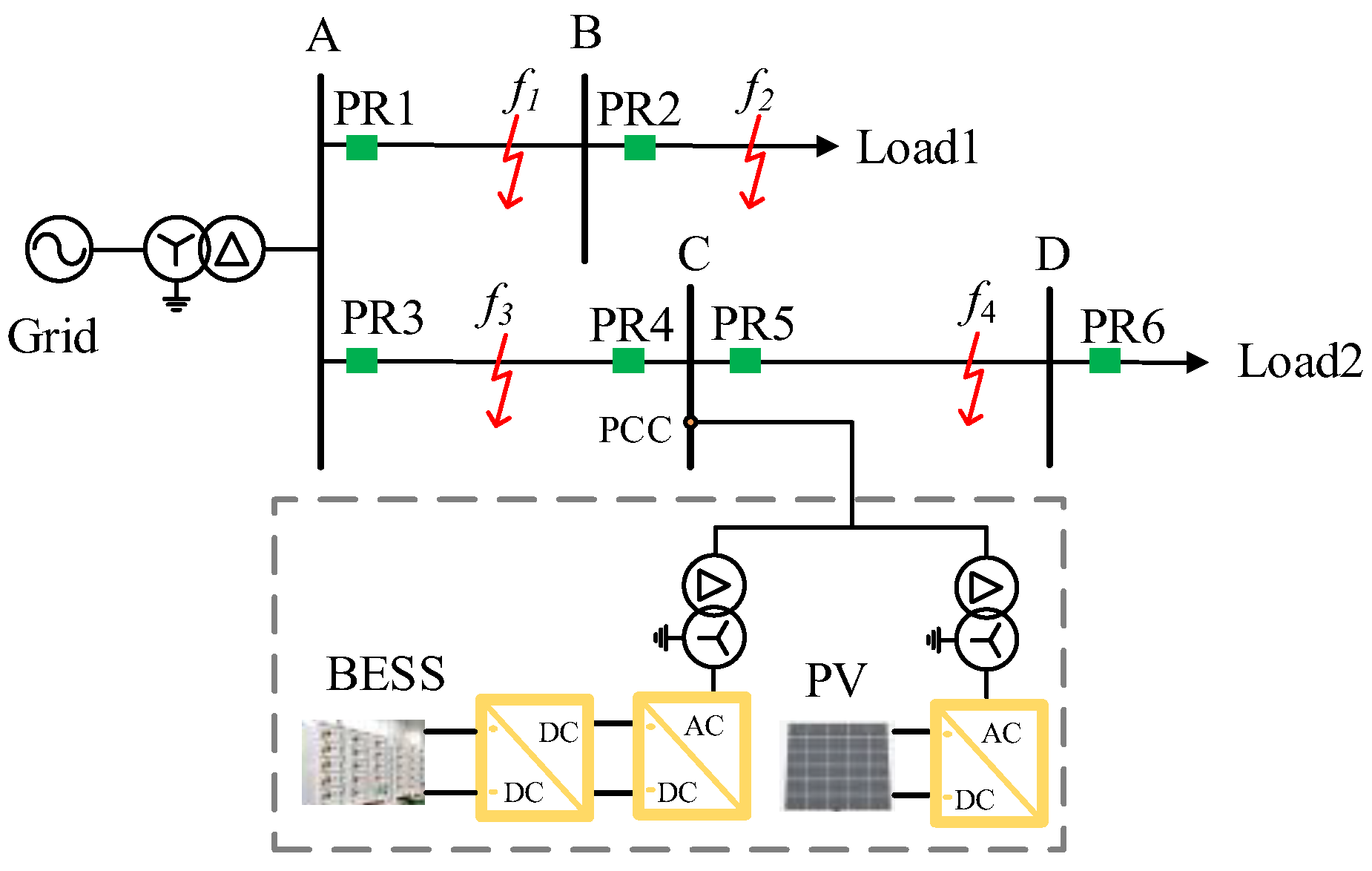
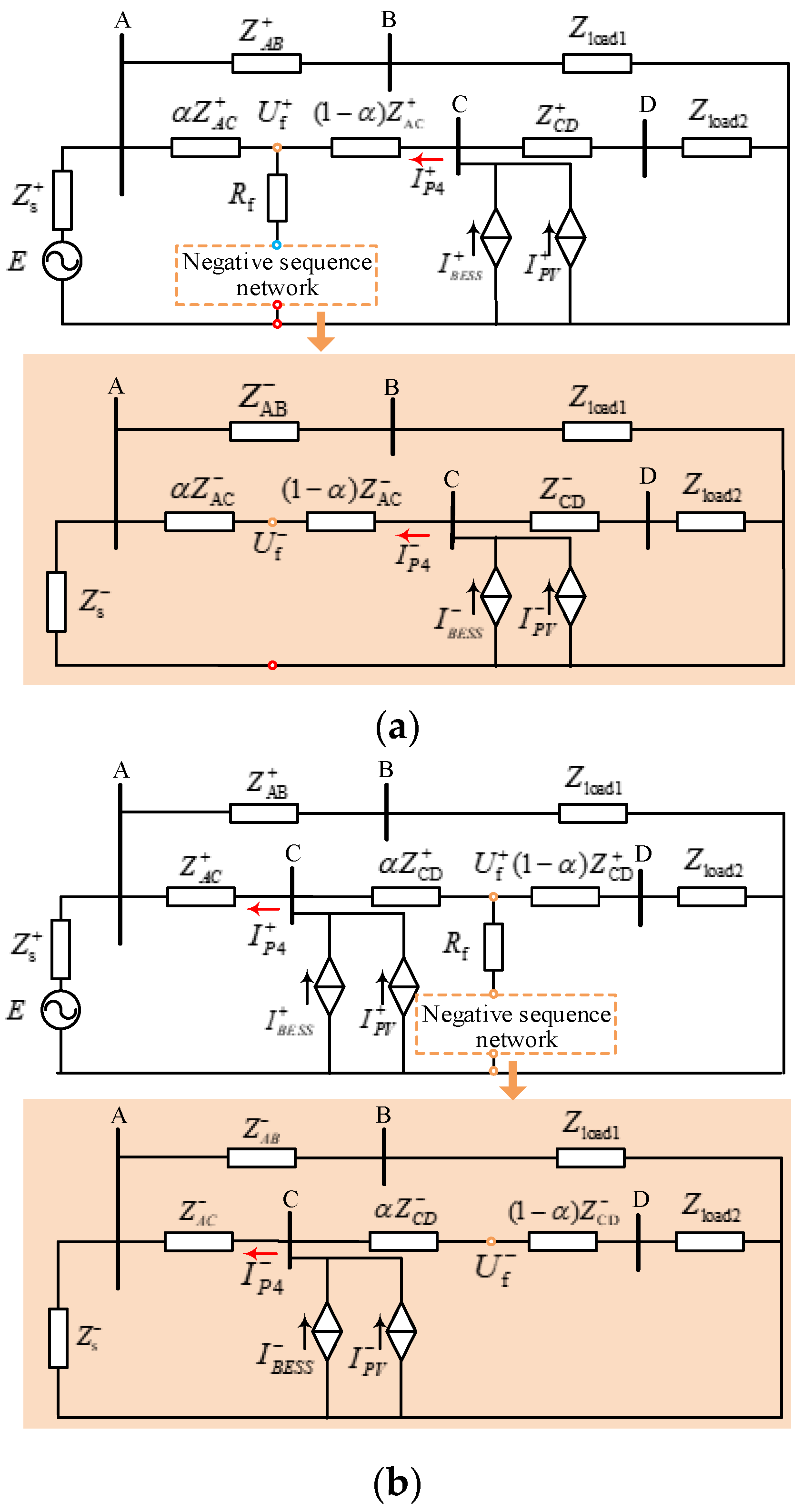
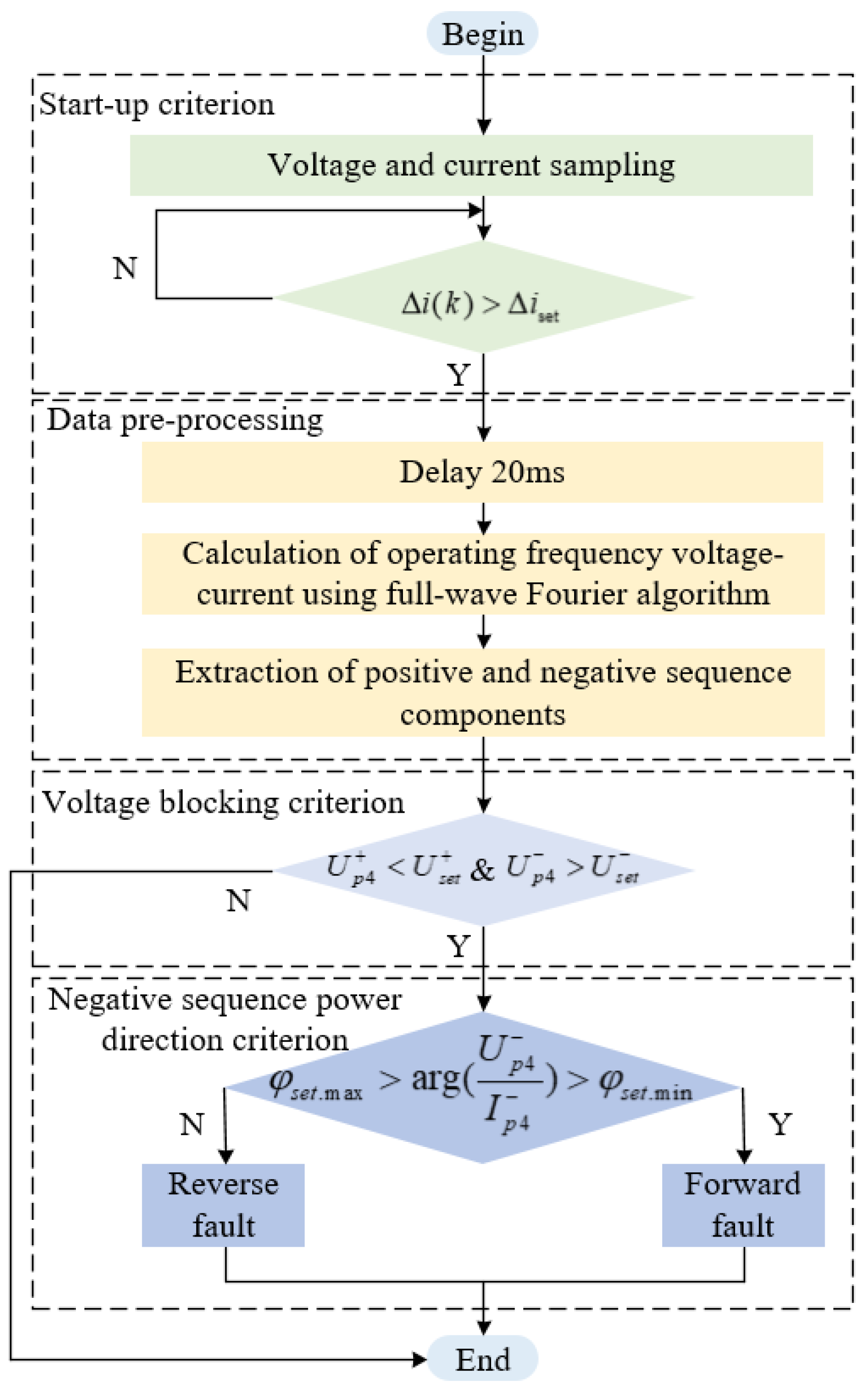
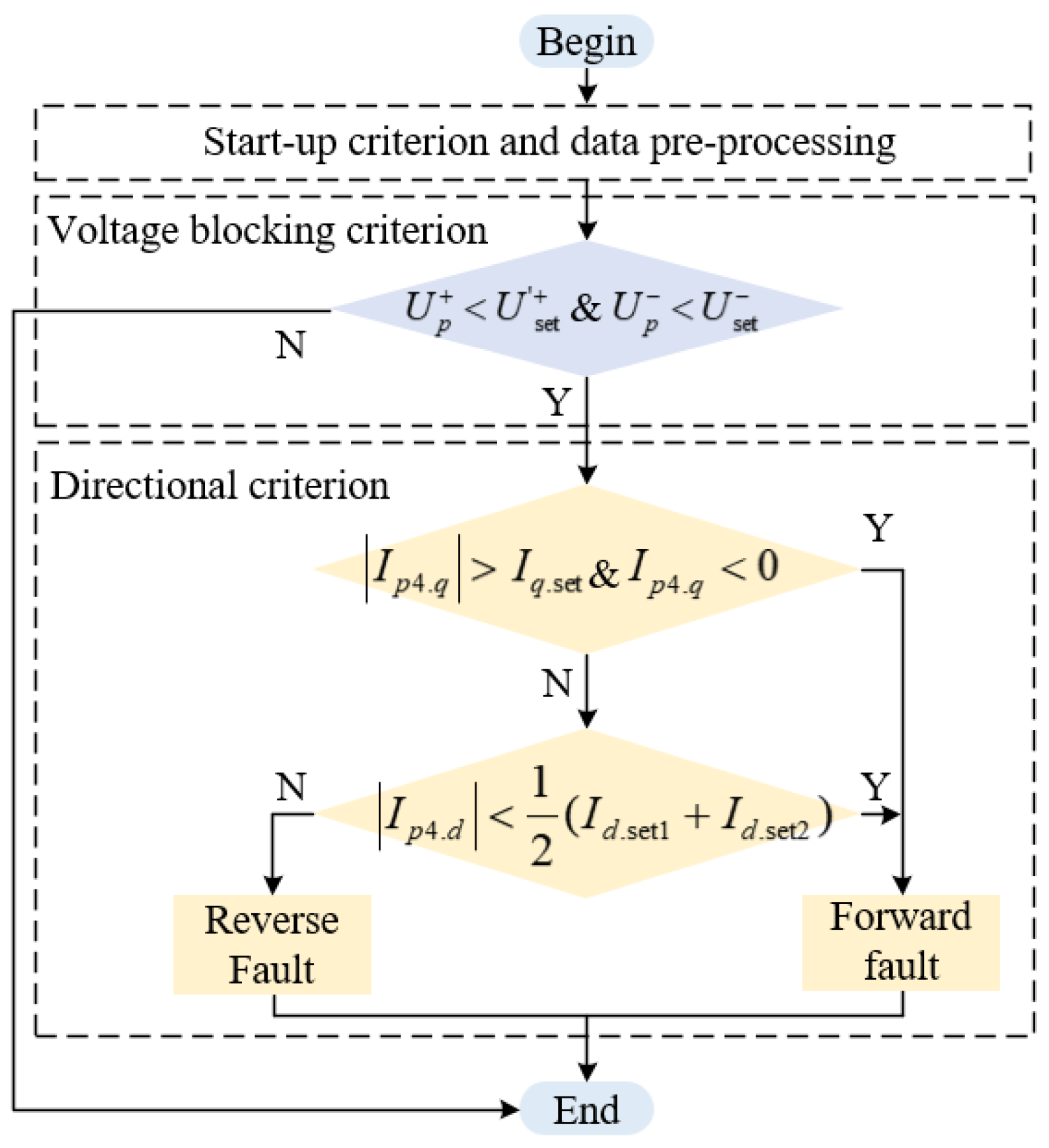
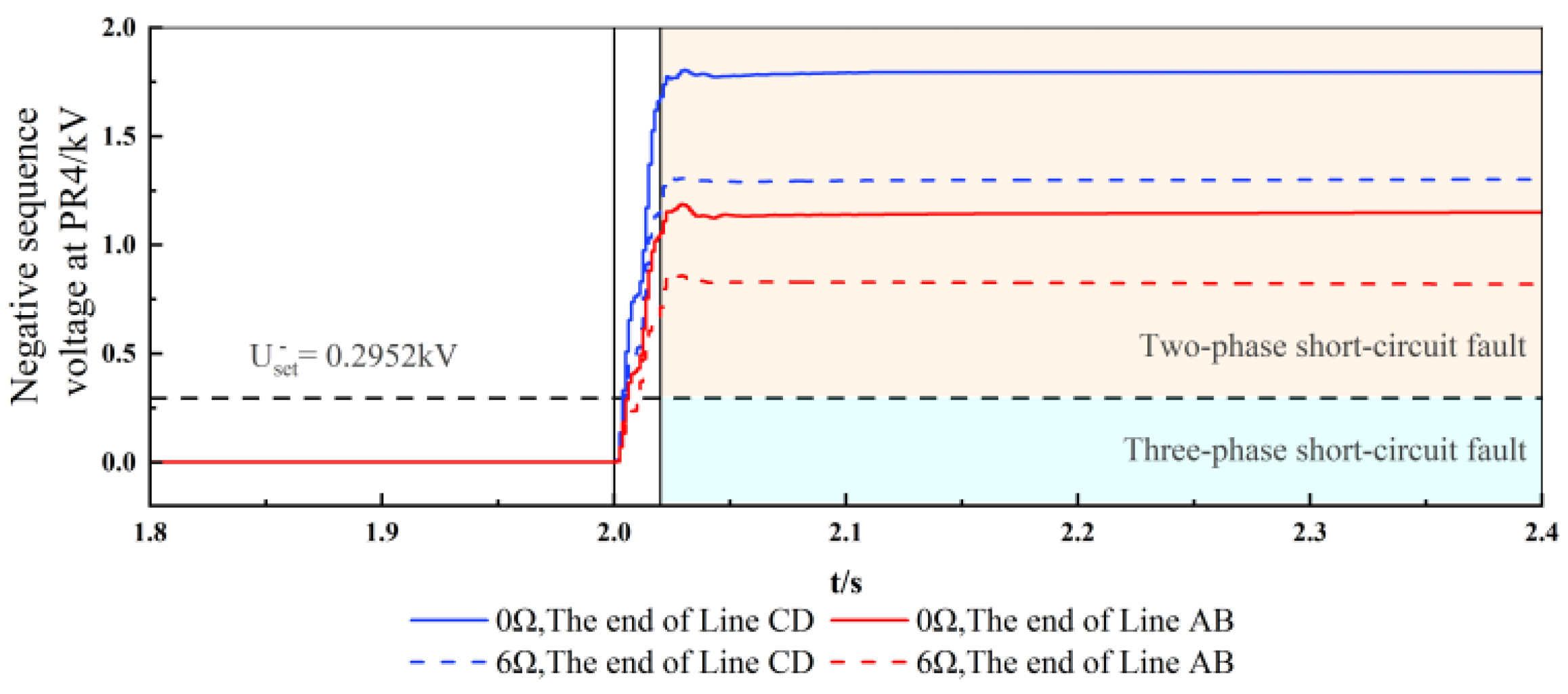
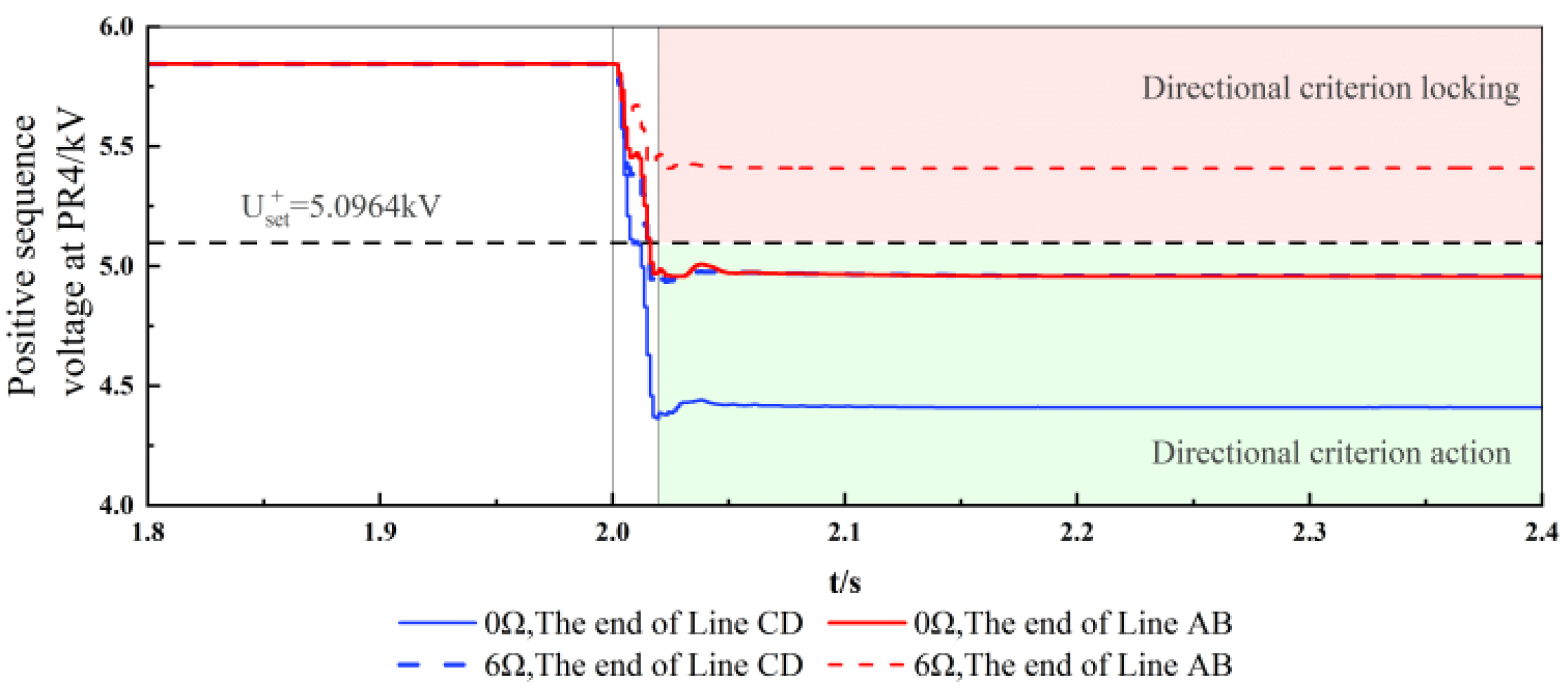
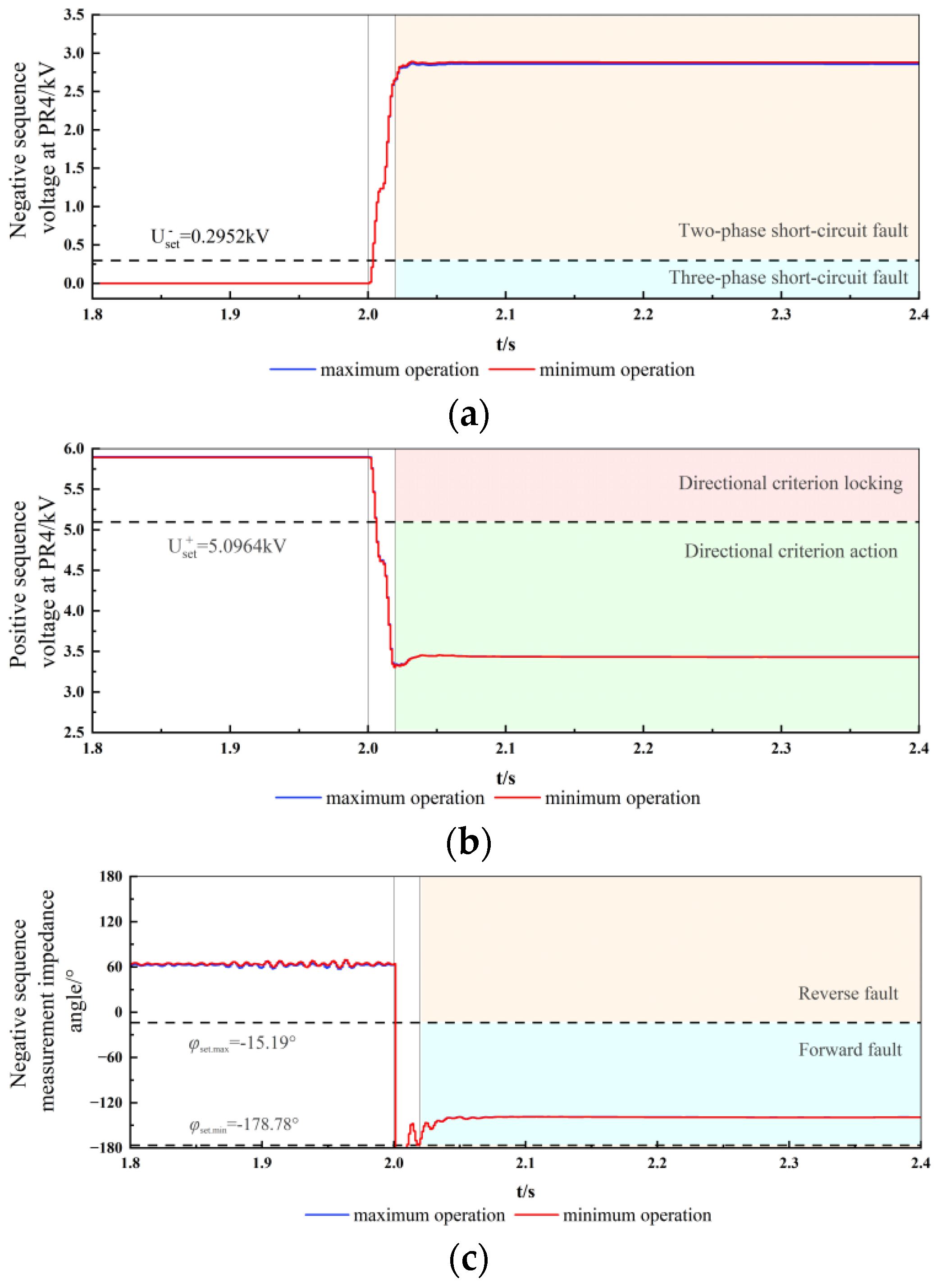
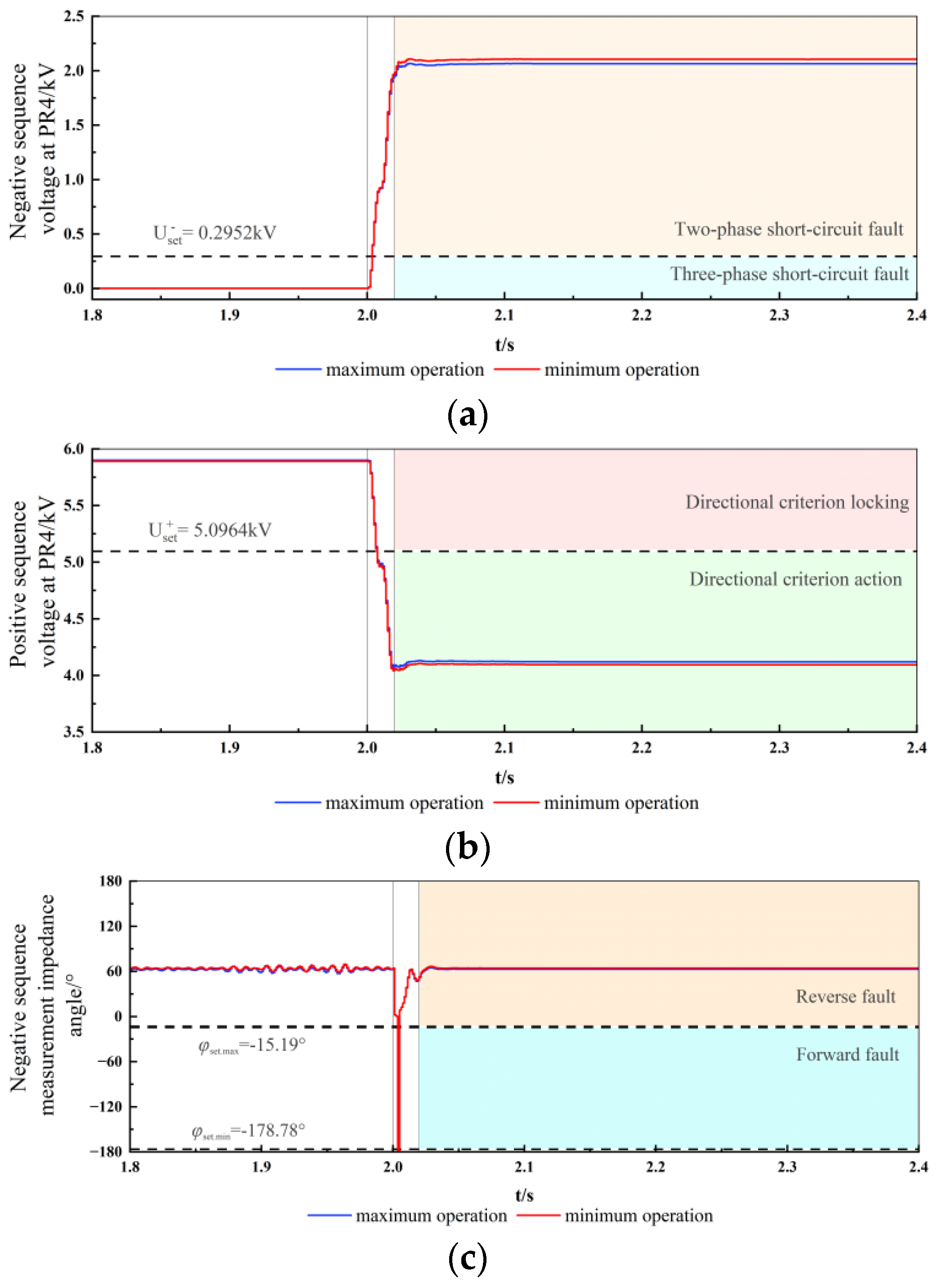
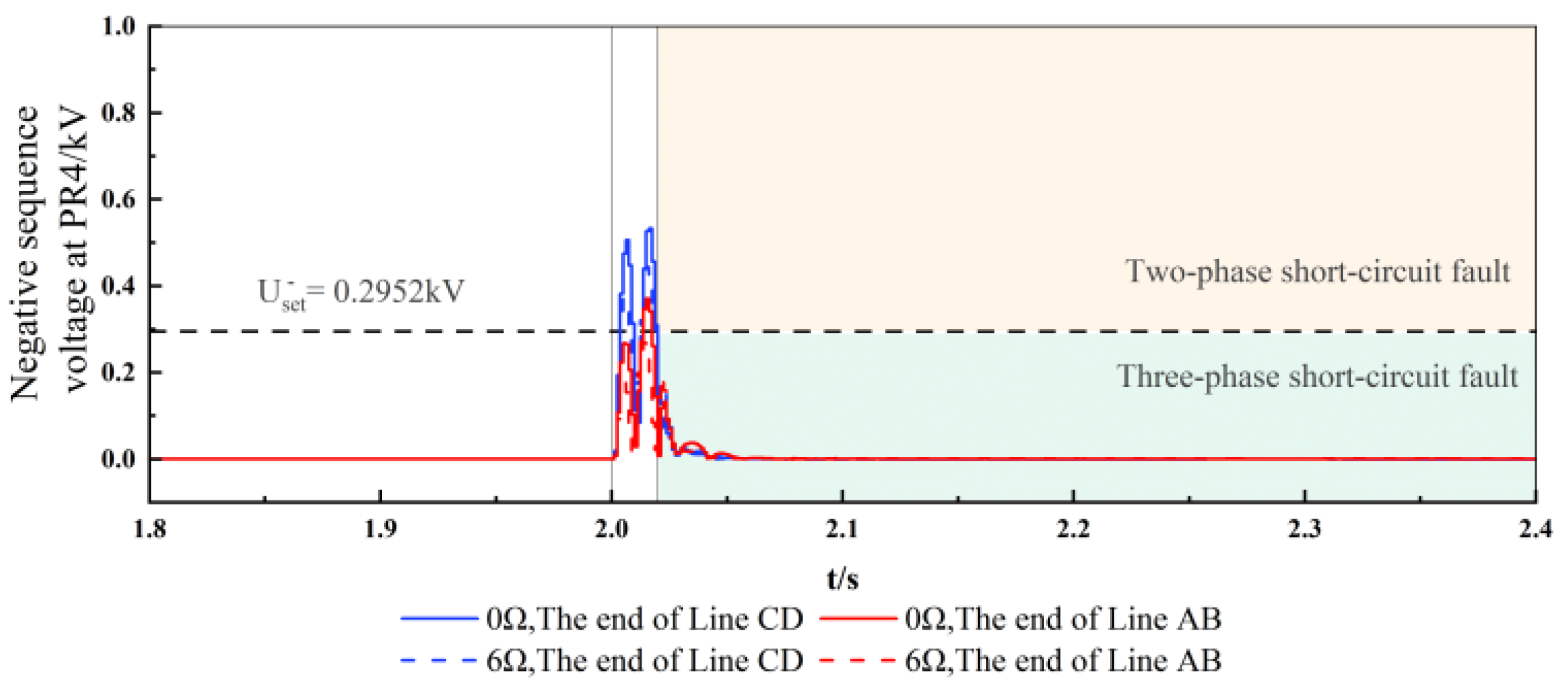
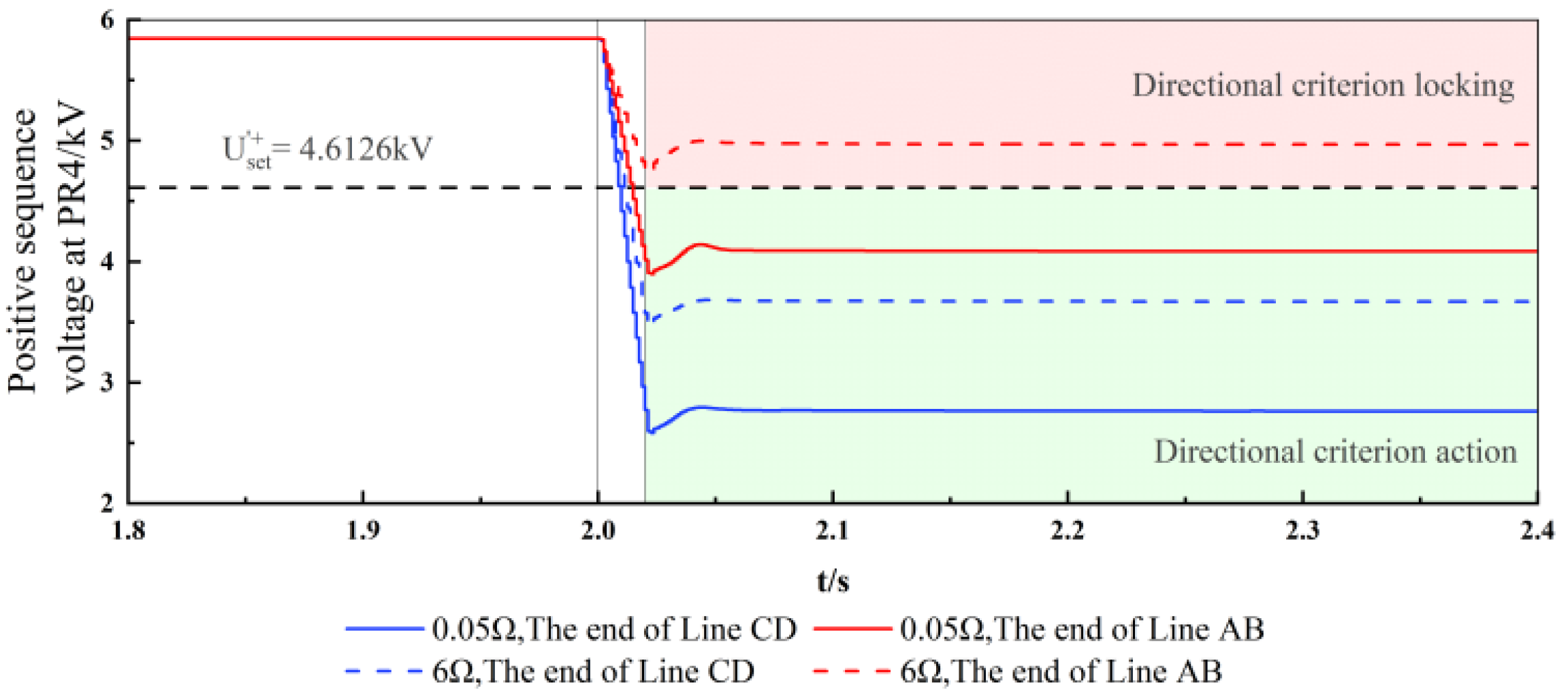
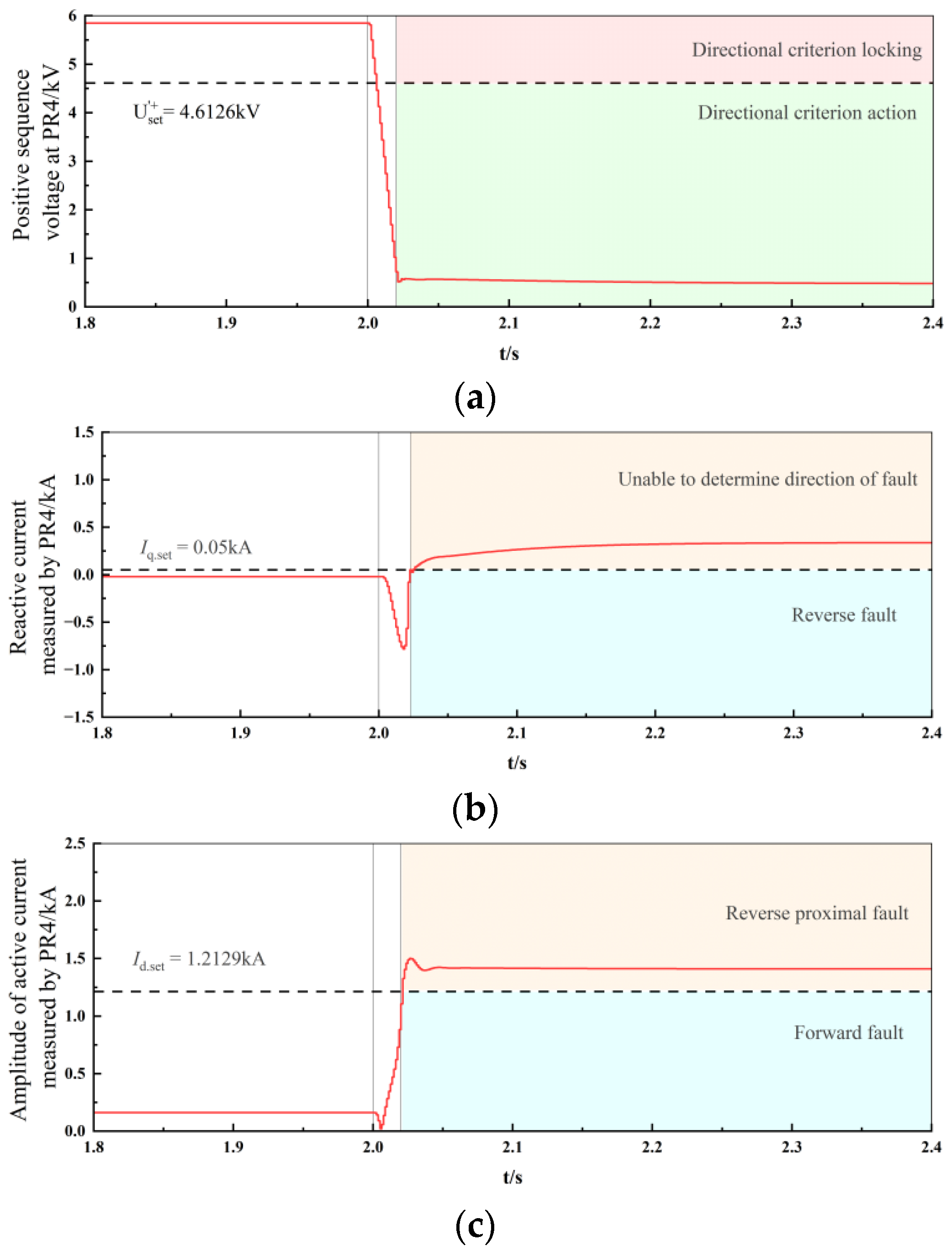
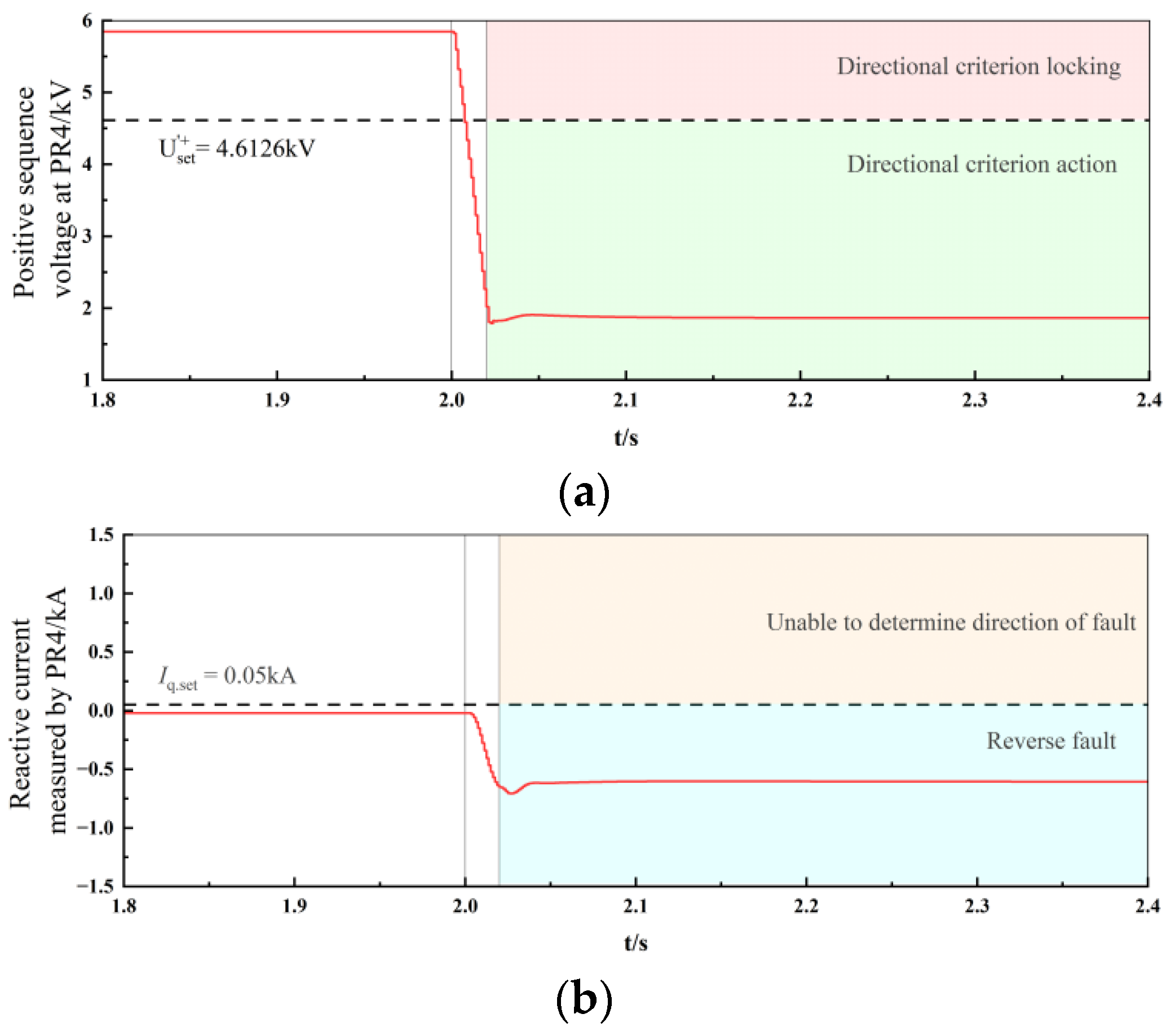
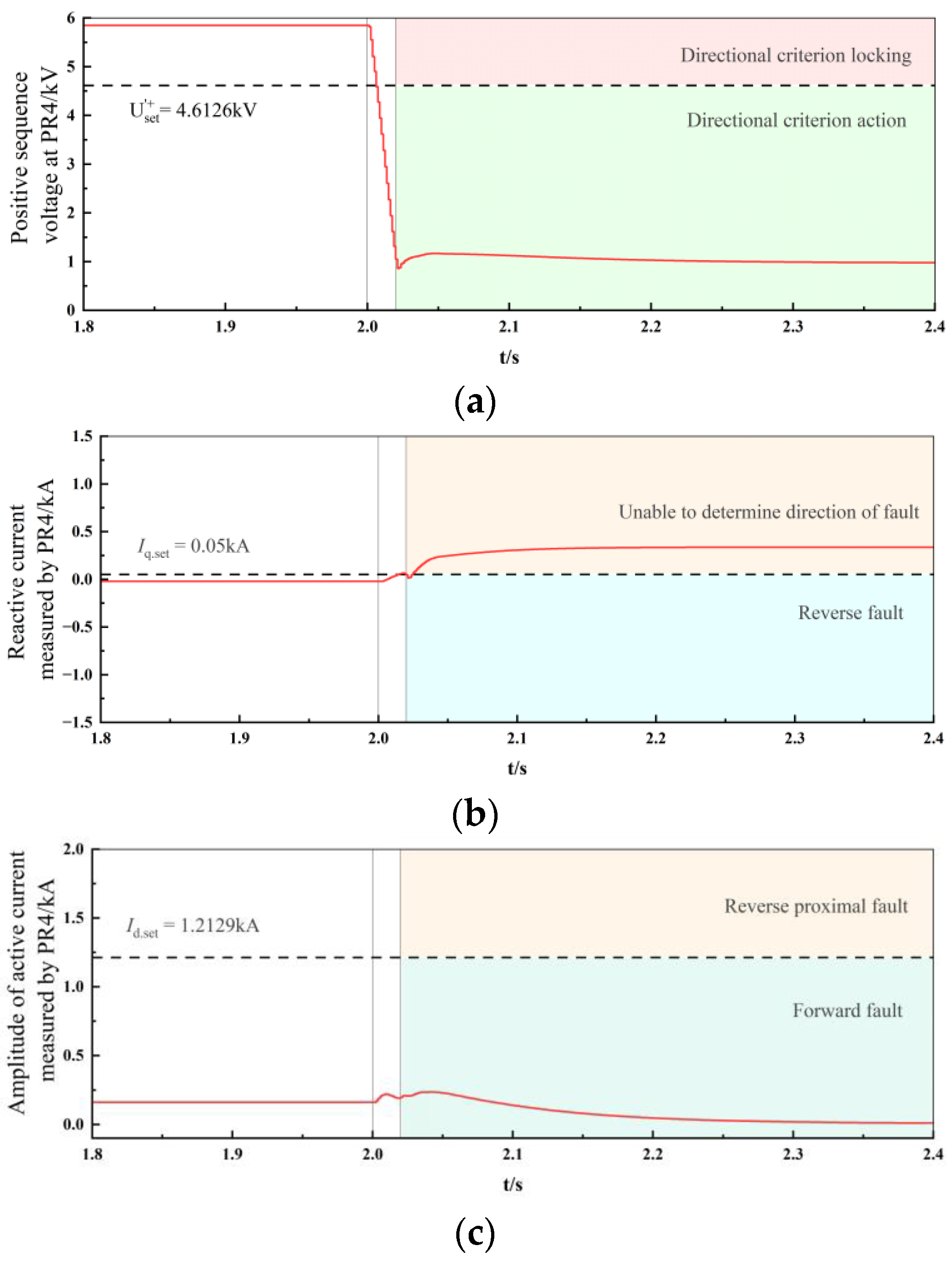
| System Parameters | Parameter Value |
|---|---|
| Rated voltage/frequency of the AC system | 10 kV/50 Hz |
| AC voltage of the converter | 0.4 kV |
| DC voltage of the converter | 1.0 kV |
| Rated capacity of the PV | 5 MVA |
| Rated capacity of the BESS power station | 1 MVA |
| Capacities of loads Load1 and Load2 | 2.5 MVA |
| Power factors of loads Load1 and Load2 | 0.87 |
| Length of line AB | 4 km |
| Lengths of lines AC and CD | 5 km |
| Unit Impedance of the line | 0.26 + j0.42 Ω/km |
| Equivalent impedance under the maximum operating mode of the system | j0.45 Ω |
| Equivalent impedance under the minimum operating mode of the system | j0.63 Ω |
Disclaimer/Publisher’s Note: The statements, opinions and data contained in all publications are solely those of the individual author(s) and contributor(s) and not of MDPI and/or the editor(s). MDPI and/or the editor(s) disclaim responsibility for any injury to people or property resulting from any ideas, methods, instructions or products referred to in the content. |
© 2025 by the authors. Licensee MDPI, Basel, Switzerland. This article is an open access article distributed under the terms and conditions of the Creative Commons Attribution (CC BY) license (https://creativecommons.org/licenses/by/4.0/).
Share and Cite
He, J.; Li, L.; Niu, J.; Liang, Y.; Liu, H.; Yang, Z.; Li, C.; Zheng, Z. Fault Analysis and Protection Principle for the Distribution Networks Integrated with PV and BESS. Appl. Sci. 2025, 15, 5568. https://doi.org/10.3390/app15105568
He J, Li L, Niu J, Liang Y, Liu H, Yang Z, Li C, Zheng Z. Fault Analysis and Protection Principle for the Distribution Networks Integrated with PV and BESS. Applied Sciences. 2025; 15(10):5568. https://doi.org/10.3390/app15105568
Chicago/Turabian StyleHe, Jianan, Lei Li, Jian Niu, Yabo Liang, Haitao Liu, Zhenxin Yang, Chao Li, and Zhihui Zheng. 2025. "Fault Analysis and Protection Principle for the Distribution Networks Integrated with PV and BESS" Applied Sciences 15, no. 10: 5568. https://doi.org/10.3390/app15105568
APA StyleHe, J., Li, L., Niu, J., Liang, Y., Liu, H., Yang, Z., Li, C., & Zheng, Z. (2025). Fault Analysis and Protection Principle for the Distribution Networks Integrated with PV and BESS. Applied Sciences, 15(10), 5568. https://doi.org/10.3390/app15105568






